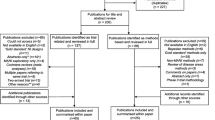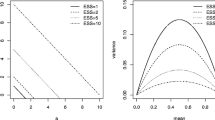Abstract
Non-inferiority (NI) trials have gained recognition as an effective tool with which to search for substitutes for a standard treatment that is associated with certain undesirable features, such as adverse side-effects, an exorbitant cost, or an extremely complicated therapeutic regimen. Statistical methods have been developed for NI studies with multiple experimental treatments. However, experimental treatments sometimes represent a new treatment with various dose levels, and in such circumstances, identification of the minimum non-inferior dose is a reasonable objective of the trial. Thus, we examine several potential testing procedures with respect to this testing objective. A simulation study is conducted to evaluate their performance, and determination of the sample size is discussed. Two clinical examples are provided to illustrate the proposed method.
Similar content being viewed by others
References
Bachelez, H., Van de Kerkhof, P., Strohal, R., Kubanov, A., Valenzuela, F., Lee, J. H., et al. (2015). Tofacitinib versus etanercept or placebo in moderate-to-severe chronic plaque psoriasis: A phase 3 randomised non-inferiority trial. Lancet, 386, 552–561.
Beeh, K. M., Derom, E., Kanniess, F., Cameron, R., Higgins, M., & Van As, A. (2007). Indacaterol, a novel inhaled beta 2-agonist, provides sustained 24-hour bronchodilation in asthma. European Respiratory Journal, 29, 871–878.
Bossche, L. V., & Vanderstraeten, G. (2015). A multi-center, double-blind, randomized, placebo-controlled trial protocol to assess traumeel injection vs dexamethasone injection in rotator cuff syndrome: the TRAumeel in ROtator cuff syndrom (TRARO) study protocol. BMC Musculoskeletal Disorders, 16, 8.
Burger, H. U., Beyer, U., & Abt, M. (2011). Issues in the assessment of non-inferiority: Perspectives drawn from case studies. Pharmaceutical Statistics, 10, 433–439.
Cazzola, M., & Matera, M. G. (2009). Emerging inhaled bronchodilators: An update. European Respiratory Journal, 34, 757–769.
Donohue, J. F., Fogarty, C., Lötvall, J., Worth, H., Yorgancioglu, A., Iqbal, A., et al. (2010). Once-daily bronchodilators for chronic obstructive pulmonary disease: Indacaterol versus tiotropium. American Journal of Respiratory and Critical Care Medicine, 182, 155–162.
Dunnett, C. W. (1955). A multiple comparison procedure for comparing several treatments with a control. Journal of the American Statistical Association, 50, 1096–1121.
Dunnett, C. W., & Tamhane, A. C. (1992). A step-up multiple test procedure. Journal of the American Statistical Association, 87, 162–170.
Ellenberg, S. S., & Temple, R. (2000). Placebo-controlled trials and active-control trials in the evaluation of new treatments. Part 2: Practical issues and specific cases. Annals of Internal Medicine, 133, 464–470.
European Medicines Agency. (2006). Guideline on the Choice of the Non-inferiority Margin. London: EMA. https://www.ema.europa.eu/en/documents/scientific-guideline/guideline-choice-non-inferiority-margin_en.pdf. Retrieved 12 June 2019.
Fleming, T. R., Odem-Davis, K., Rothmann, M. D., & Yan, L. S. (2011). Some essential considerations in the design and conduct of non-inferiority trials. Clinical Trials, 8, 432–439.
Fleming, T. R., & Powers, J. H. (2008). Issues in noninferiority trials: The evidence in community-acquired pneumonia. Clinical Infectious Diseases, 47, S108–S120.
Food and Drug Administration. (2016). Guidance for Industry Non-inferiority Clinical Trials-Draft Guidance. Rockville: FDA. https://www.fda.gov/media/78504/download. Retrieved 12 June 2019.
Gallwitz, B., Rosenstock, J., Rauch, T., Bhattacharya, S., Patel, S., von Eynatten, M., et al. (2012). 2-year efficacy and safety of linagliptin compared with glimepiride in patients with type 2 diabetes inadequately controlled on metformin: A randomised, double-blind, non-inferiority trial. Lancet, 380, 475–483.
Gamalo-Siebers, M., Gao, A., Lakshminarayanan, M., Liu, G., Natanegara, F., Railkar, R., et al. (2016). Bayesian methods for the design and analysis of noninferiority trials. Journal of Biopharmaceutical Statistics, 26, 823–841.
Ghosh, S., Ghosh, S., & Tiwari, R. C. (2014). Bayesian approach for assessing non-inferiority in a three-arm trial with pre-specified margin. Statistics in Medicine, 35, 695–708.
Hung, H. M., Wang, S. J., & O’Neill, R. (2009). Challenges and regulatory experiences with non-inferiority trial design without placebo arm. Biometrical Journal, 51, 324–334.
Jendle, J., Grunberger, G., Blevins, T., Giorgino, F., Hietpas, R. T., & Botros, F. T. (2016). Efficacy and safety of dulaglutide in the treatment of type 2 diabetes: A comprehensive review of the dulaglutide clinical data focusing on the AWARD phase 3 clinical trial program. Diabetes Metabolism Research and Reviews, 32, 776–790.
Kwong, K. S., Cheung, S. H., & Hayter, A. J. (2016). Step-up procedures for non-inferiority tests with multiple experimental treatments. Statistical Methods in Medical Research, 25, 1290–1302.
Kwong, K. S., Cheung, S. H., Hayter, A. J., & Wen, M. J. (2012). Extension of three-arm non-inferiority studies to trials with multiple new treatments. Statistics in Medicine, 31, 2833–2843.
Kwong, K. S., & Liu, W. (2000). Calculation of critical values for Dunnett and Tamhane’s step-up multiple test procedure. Statistics and Probability Letters, 49, 411–416.
Madsbad, S., Schmitz, O., Ranstam, J., Jakobsen, G., & Matthews, D. R. (2004). Improved glycemic control with no weight increase in patients with type 2 diabetes after once-daily treatment with the long-acting glucagon-like peptide 1 analog liraglutide (NN2211): A 12-week, double-blind, randomized, controlled trial. Diabetes Care, 27, 1335–1342.
Nauck, M., Frid, A., Hermansen, K., Shah, N. S., Tankova, T., Mitha, I. H., et al. (2009). Efficacy and safety comparison of liraglutide, glimepiride, and placebo, all in combination with metformin, in type 2 diabetes. Diabetes Care, 32, 84–90.
Nauck, M., Weinstock, R. S., Umpierrez, G. E., Guerci, B., Skrivanek, Z., & Millicevic, Z. (2014). Efficacy and safety of dulaglutide versus sitagliptin after 52 weeks in type 2 diabetes in a randomized controlled trial. Diabetes Care, 37, 2149–2158.
Ridderstråle, M., Andersen, K. R., Zeller, C., Kim, G., Woerle, H. J., Broedl, U. C., & EMPA-REG H2H-SU trial investigators. (2014). Comparison of empagliflozin and glimepiride as add-on to metformin in patients with type 2 diabetes: A 104-week randomised, active-controlled, double-blind, phase 3 trial. The Lancet Diabetes and Endocrinology, 2, 691–700.
Roberts, V. L., Stewart, J., Issa, M., Lake, B., & Melis, R. (2005). Triple therapy with glimepiride in patients with type 2 diabetes mellitus inadequately controlled by metformin and a thiazolidinedione: Results of a 30-week, randomized, double-blind, placebo-controlled, parallel-group study. Clinical Therapeutics, 27, 1535–1547.
Skrivanek, Z., Gaydos, B. L., Chien, J. Y., Geiger, M. J., Heathman, M. A., Berry, S., et al. (2014). Dose-finding results in an adaptive, seamless, randomized trial of once-weekly dulaglutide combined with metformin in type 2 diabetes patients (AWARD5). Diabetes, Obesity and Metabolism, 16, 748–756.
Sundar, S., Sinha, P. K., Rai, M., Verma, D. K., Nawin, K., Alam, S., et al. (2011). Comparison of short-course multidrug treatment with standard therapy for visceral leishmaniasis in India: An open-label, non-inferiority, randomised controlled trial. Lancet, 377, 477–486.
Tamhane, A. C., Dunnett, C. W., Green, J., & Wetherington, J. (2001). Multiple test procedures for identifying the maximum safe dose. Journal of the American Statistical Association, 96, 835–843.
Tamhane, A. C., Hochberg, Y., & Dunnett, C. W. (1996). Multiple test procedures for dose finding. Biometrics, 52, 21–37.
Tamhane, A. C., & Logan, B. R. (2002). Multiple test procedures for identifying the minimum effective and maximum safe doses of a drug. Journal of the American Statistical Association, 97, 293–301.
Tamhane, A. C., Shi, K., & Strassburger, K. (2006). Power and sample size determination fot a stepwise test procedure for finding the maximum safe dose. Journal of Statistical Planning and Inference, 136, 2163–2181.
Vilsbøll, T., Zdravkovic, M., Le-Thi, T., Krarup, T., Schmitz, O., Courrges, J. P., et al. (2007). Liraglutide, a long-acting human glucagon-like peptide-1 analog, given as monotherapy significantly improves glycemic control and lowers body weight without risk of hypoglycemia in patients with type 2 diabetes. Diabetes Care, 30, 1608–1610.
Wolfsegger, M. J., Gutjahr, G., Engl, W., & Jaki, T. (2014). A hybrid method to estimate the minimum effective dose for monotone and non-monotone dose-response relationships. Biometrics, 70, 103–109.
Xu, W., Hu, F., & Cheung, S. H. (2018). Adaptive design for non-inferiority trials with multiple experimental treatments. Statistical Methods in Medical Research, 27, 3255–3270.
Zhong, J., Wen, M. J., Kwong, K. S., & Cheung, S. H. (2018). Testing of non-inferiority and superiority for three-arm clinical studies with multiple experimental treatments. Statistical Methods in Medical Research, 27, 1751–1765.
Acknowledgements
We are grateful to the referees who provided very helpful suggestions and comments. Zhong’s research was supported by the Natural Science Foundation of Fujian Province, China (2018J01430) and a research grant from Xiamen University of Technology, China (YKJ17003R). Wen’s research was supported by the Ministry of Science and Technology, Taiwan, MOST 108-2118-M-006-008, and MOST 107-2118-M-006-005. Cheung’s research was supported by the Research Grants Council of the Hong Kong Special Administrative Region (CUHK14304916) and a direct grant from The Chinese University of Hong Kong.
Author information
Authors and Affiliations
Corresponding author
Ethics declarations
Conflict of interest
The authors declare that they have no conflict of interest.
Additional information
Publisher's Note
Springer Nature remains neutral with regard to jurisdictional claims in published maps and institutional affiliations.
Rights and permissions
About this article
Cite this article
Zhong, J., Wen, MJ. & Cheung, S.H. Identification of the minimum non-inferior dose in a three-arm non-inferiority trial. J. Korean Stat. Soc. 49, 1238–1254 (2020). https://doi.org/10.1007/s42952-020-00053-w
Received:
Accepted:
Published:
Issue Date:
DOI: https://doi.org/10.1007/s42952-020-00053-w
Keywords
- Assay sensitivity
- Familywise error rate
- Minimum non-inferior dose
- Test power
- Three-arm non-inferiority trial




